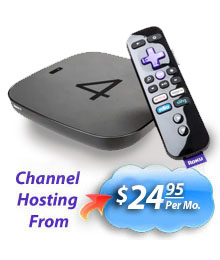How To Build a Roku Live Streaming Channel
The Roku streaming platform has become increasingly popular for both content consumers and creators. While it's relatively simple to access existing channels on Roku, creating your own channel, especially one that can live stream content, may seem like a daunting task. However, with the right approach and tools, building a Roku channel for live streaming is well within reach. In this article, we'll guide you through the process step by step.
While many streaming companies offer a live streaming Roku channel, very few offer an affordable solution for building a live stream channel. Most of the live streaming options you will find require you to spend hundreds or thousands per month to create and host the channel. However, in this article we will show you how to use our channel creation services and build an affordable live streaming channel that you can operate without incurring large expenses.
Let's dive deeper into the steps involved in live streaming on a Roku channel:
Step 1: Plan Your Live Stream
To effectively plan your live stream, consider the following:
- Audience: Who is your target audience? Understanding your viewers' preferences will help you tailor your channel accordingly.
- Branding: Create a brand identity for your channel, including a logo, colors, and a catchy name that reflects your content.
- Content Strategy: Decide what type of content you want to stream. This could be anything from live sports events and gaming sessions to product demonstrations and interviews. Ensure it aligns with your target audience's interests.
- Broadcast Schedule: Establish a consistent schedule for your live streams. Consistency helps build an audience as viewers know when to expect new content.
- Equipment and Resources: Invest in the necessary equipment, such as cameras, microphones, lighting, and a reliable Internet connection. Ensure you have enough resources to handle the technical aspects of live streaming.
- Engagement Strategies: Plan how you will engage with your audience during the live stream. This could include responding to comments, conducting Q&A sessions, or running polls and giveaways.
- Legal Considerations: Ensure you have the rights to stream the content you plan to provide. Be aware of copyright laws and licensing agreements.
Step 2: Prepare Your Equipment
Live streaming requires specific hardware equipment to ensure the smooth capture and broadcast of video and audio content. The exact hardware you need can vary depending on your streaming goals and the complexity of your setup, but here's a general overview of the essential hardware equipment for live streaming:
- Camera: A good camera is crucial for high-quality video. While webcams can suffice for some applications, professional streamers often use DSLR or mirrorless cameras with clean HDMI outputs for better image quality. Camcorders and action cameras are also suitable choices. Ensure your camera supports continuous recording and is capable of outputting a clean video signal without overlays or icons.
- Microphone: Clear and high-quality audio is equally important. Consider investing in an external microphone, such as a USB condenser microphone or an XLR microphone
connected to an audio interface. Lavaliere (lapel) microphones or shotgun microphones can also be useful depending on your recording environment. - Computer: A powerful computer is essential for encoding and broadcasting your live stream. It should meet or exceed the recommended system requirements for your chosen streaming software or encoder. Ensure you have enough RAM, a capable CPU, and a dedicated GPU if you plan to use software encoding. For more advanced setups, some streamers build custom streaming PCs for optimal performance.
- Lighting: Good lighting is key to a visually appealing stream. Invest in lighting equipment like softboxes, ring lights, or LED panels to ensure well-lit and evenly exposed video.
Proper lighting also helps reduce shadows and improves overall image quality. - Green Screen (Optional): For those who want to add custom backgrounds or remove the background altogether, a green screen can be a valuable addition. It allows you to superimpose your video feed onto other content during the live stream.
- Tripods and Mounts: Stabilization is essential to prevent shaky footage. Tripods or camera mounts help keep your camera steady during streaming. Consider versatile options like tripod arms for overhead shots or flexible tripod stands for creative camera angles.
- Internet Connection: A stable and high-speed Internet connection is critical for streaming. Ensure that your upload speed meets the requirements of your streaming platform and encoder. A wired Ethernet connection is preferred for reliability, but a strong Wi-Fi connection can suffice if properly configured.
- Headphones: Monitoring audio during your live stream is essential. Invest in a good pair of closed-back headphones to accurately hear your audio levels and ensure there are no issues with echo or background noise.
- Audio Interface (Optional): For advanced audio setups with XLR microphones and multiple audio sources, an audio interface can be helpful. It allows you to manage audio input and output with greater control.
Remember that your specific hardware needs may vary depending on your content and budget. It's important to choose equipment that aligns with your streaming goals and provides the level of quality and professionalism you desire for your live broadcasts.
Step 3: Choose a Live Stream Software. Live stream encoders play a pivotal role in the live streaming workflow. They act as intermediaries between the content source, such as a camera or computer screen, and the online streaming platform. Encoders are responsible for converting raw video and audio data into a format that can be easily transmitted over the Internet, often using industry-standard protocols like RTMP (Real-Time Messaging Protocol) or HLS (HTTP Live Streaming).
OBS Studio: A Powerful and Free Encoder OBS Studio is an open-source, cross-platform live stream encoder that has gained immense popularity among content creators, gamers, and businesses. Here are some key features and benefits of OBS Studio:
- Ease of Use: OBS Studio boasts an intuitive interface that is accessible to both beginners and experienced streamers. Setting up a live stream is straightforward, and the software offers a wide range of configuration options.
- Multi-Platform Support: OBS Studio is compatible with Windows, macOS, and Linux, making it accessible to a broad user base.
- Customizability: Users can customize their live streams with various scenes, sources, and overlays. This flexibility allows for professional-looking broadcasts tailored to the creator's unique style.
- Encoding Options: OBS Studio supports hardware and software encoding, which means it can leverage your computer's hardware (such as your GPU) to improve encoding performance.
- Integration: It seamlessly integrates with popular streaming platforms like Twitch, YouTube, Facebook Live, and more. Streamers can easily link OBS Studio to their chosen platform using stream keys.
- Plugins and Extensions: OBS Studio supports a robust ecosystem of plugins and extensions, allowing users to extend its functionality to meet specific needs.
Whether you're a gamer looking to stream your gameplay, a content creator sharing educational content, or a business conducting webinars, OBS Studio's versatility and feature set make it a valuable tool for encoding and broadcasting live video and audio content. It empowers creators to engage their audience, deliver professional-quality streams, and share their content with the world. Plus, being open-source, it's an accessible and cost-effective option for streamers of all levels.
Step 4: Choose a Streaming Platform
Choosing a streaming platform is very important. streaming platforms allow you to connect streaming software like OBS Studio to a streaming platform like DaCast which then produces a live stream that can be viewed on your streaming devices like Roku.
Dacast is a professional streaming service that empowers content creators, businesses, and organizations to broadcast their live streams with ease and reliability. Offering a robust set of features and tools, Dacast is known for its user-friendly interface, scalability, and high-quality streaming capabilities.
- High-Quality Streaming: One of the standout features of Dacast is its commitment to delivering high-quality video and audio streaming. It supports adaptive bitrate streaming, ensuring viewers receive the best possible quality based on their Internet connection. This feature is especially crucial for reaching a diverse audience with varying bandwidth capabilities.
- Multi-Platform Streaming: Dacast allows users to simulcast their live streams to multiple platforms simultaneously. Whether you want to broadcast on your website, social media channels like Facebook and YouTube, or even through mobile apps, Dacast offers the flexibility to reach your audience wherever they are.
- App Stream Format: Dacast allows you to stream an M3U8 stream which is compatible with streaming devices like Roku, FireTV, mobile phone apps and more. Using M3U8 files in mobile app development for live streaming is a popular and effective approach, especially for Roku, FireTV, Apple TV, Smart TV, iOS and Android platforms. M3U8, short for "MPEG-2 Transport Stream," is a multimedia playlist format commonly used for streaming live and on-demand content.
Incorporating M3U8 files into your mobile app for live streaming allows you to leverage a widely-accepted format for streaming media while ensuring compatibility with various devices and platforms. With the right media player library and robust error-handling mechanisms, you can offer a high-quality and seamless live streaming experience to your app users.
Step 4: Test Your Live Stream
Before broadcasting to your Roku channel, test your live stream to ensure everything is working correctly. Verify video and audio quality, ensure your encoding settings are optimized, and confirm that the stream is reaching your chosen live streaming platform without issues.
Step 5: Build Your Channel
You need to create the channel app where you want to embed the M3U8 live stream. The app should be developed using the appropriate programming languages and frameworks for your target platform (e.g., Android, iOS, Roku, or web). MacMillan Interactive Communications, LLC can help you build your channel app. Please contact us for more information.
Step 6: Incorporate Your M3U8 Live Stream in Your Channel
To insert an M3U8 live stream into your channel app, you need to follow specific steps to ensure seamless integration and playback. M3U8 is a widely used format for live streaming playlists, and it can be utilized in various app development scenarios. Below, we outline the process for incorporating an M3U8 live stream into your channel app:
Retrieve the M3U8 URL: Obtain the M3U8 URL from your live streaming source or provider. This URL typically points to a server that hosts the M3U8 playlist file and its associated video and audio segments. Ensure that your streaming source supports HLS streaming and provides the necessary URLs. Input this URL in your channel and then set the live stream to play in HLS format.
Thoroughly test your app to ensure the M3U8 live stream is functioning correctly across different devices and platforms. Test for issues such as buffering, quality adaptation, and overall performance. Optimize your app and the stream for a seamless user experience.
Step 6: Publish Your Channel
Once you're confident that your app is working as expected, you can publish it on the respective app stores or platforms (e.g., Google Play Store, Apple App Store, Roku Channel Store).
Conclusion
Building a Roku channel for live streaming can be a rewarding venture, allowing you to share your content with a wide audience. While it may seem complex at first, following these steps and staying committed to providing high-quality content can help you successfully create and grow your Roku channel. Remember that the key to success lies not only in technical expertise but also in understanding your audience and consistently delivering value.
MacMillan Interactive Communications, LLC programs and develops Roku channels. Please contact MIC for a consultation on your Roku development needs. We are happy to help with your project.





